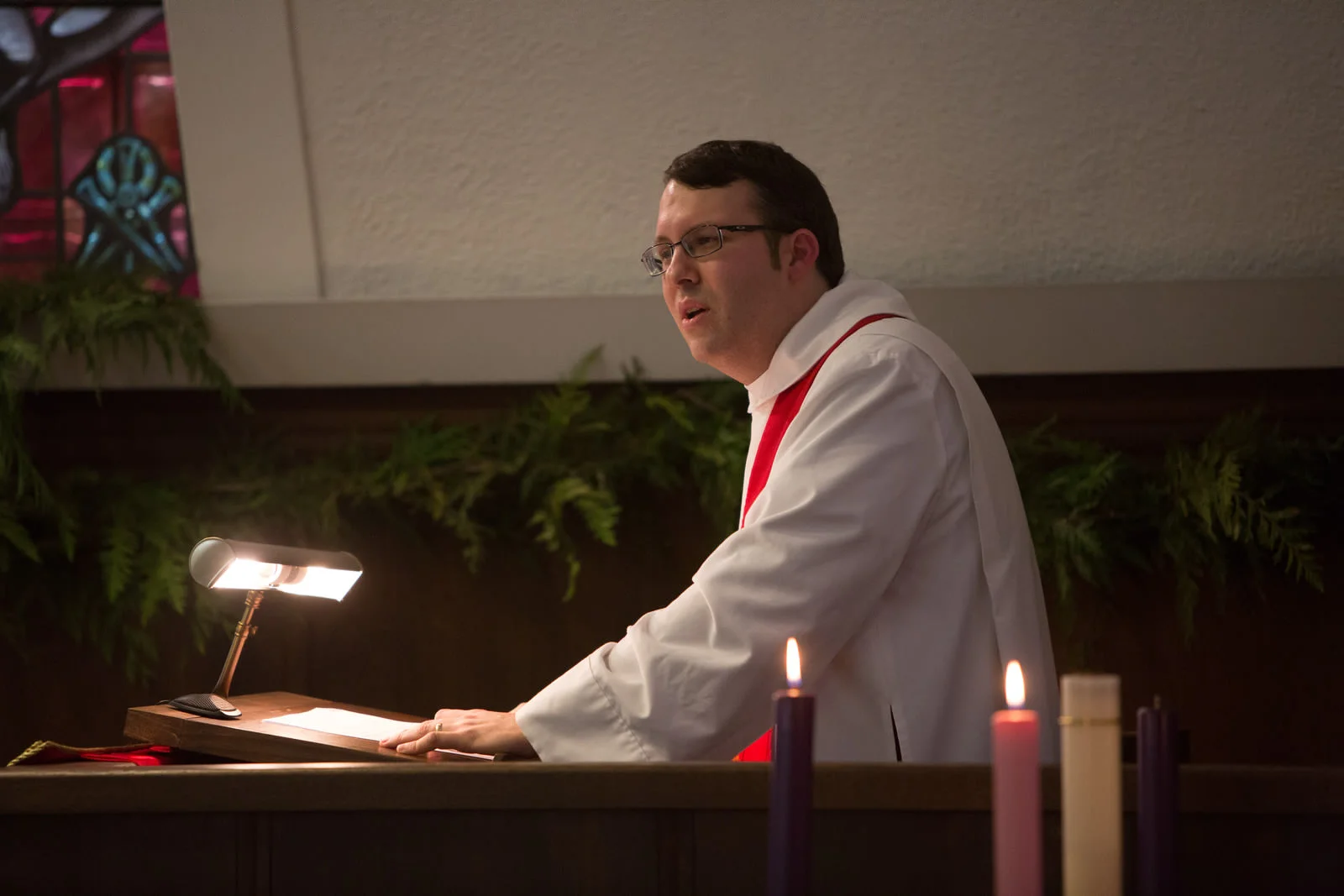A sermon for the 1st Sunday in Advent
Welcome the Stranger
Thanksgiving Sermon
There is a story we tell ourselves here in America. They may tell it elsewhere, I don’t know: this is where I live. It is the story of the self-made man or woman; that person who, out of nothing, is able to make greatness; out of nothing, become wildly successful, or rich beyond imagination, or more famous than anyone else. Out of nothing but their own fortitude and strength and virtue, nothing but their own wit and wisdom and intelligence, they are able to build greatness.
Scripture - God's Weight Room
We Episcopalians have a different view of Scripture than some of our neighbors do. Some of our neighbors want to use Scripture as a sourcebook for scientific truth. Some want to predict the future with it. Others dismiss Scripture flippantly as little more than an artifact from a barbaric culture. Neither of these will do for us Episcopalians.
Faith, Hope, and Love
Tell the story in a never-ending chain: A Sermon for All Saints
I love the All Saints hymns. There aren’t many of them, but the few there are good. For all the saints who from their labors rest... 🎶 I sing a song of the saints of God, patient and brave and true... 🎶 They have great, catchy tunes that sometimes become little earworms. And the words are meaningful and edifying. They teach us about the lives of the saints. About their courage, strength, and fortitude. About their patience, bravery, and truth. About their faith, hope, and love. These hymns teach us about people who lived their lives for God, members of the Body of Christ who tried to act as Christ’s healing hands, or Christ’s compassionate heart or Christ’s tireless feet. In some way, each saint reflected or embodied some aspect of God’s mercy, grace, peace, and love. People who, with their lives, tried to live not for themselves, but for God. They were the lights of their generations, not shining forth their own light, but shining forth the light of Christ. And they became lights for future generations, as the stories of the great cloud of witnesses strengthen us in our faith in our own generation.
🎶I sing a song of the saints of God, patient and brave and true,
who toiled and fought and lived and died for the Lord they loved and knew.
And one was a doctor, and one was a queen,
and one was a shepherdess on the green:
they were all of them saints of God- and I mean, God helping to be one too. 🎶
Apparently, the writer of the words of this hymn had particular people in mind when she wrote these lyrics. For instance, the doctor is supposed to be St. Luke, that great evangelist who is credited with writing a Gospel that now bears his name and its sequel - the Book of Acts. The queen is Margaret of Scotland, the Hungarian born queen of Scotland who worked to reform the church and founded schools, hospitals, and orphanages. The shepherdess on the green is Joan of Arc, who had visions of Jesus that gave her the strength to try and end a civil war. The soldier is supposed to be Martin of Tours, who was eventually Bishop, but was converted to the faith when he was a Roman soldier. Before his baptism, while still a soldier, he met a nearly naked man begging for help. And Martin took his massive military cloak and with his sword, cut it in half, and gave it to the man. And the next day, he had a vision of Jesus, who, echoing Matthew 25, said, “Martin, a simple catechumen, covered me with his garment.” The priest is John Donne, that great preacher and poet, and the one slain by the fierce wild beast is Ignatius of Antioch who was martyred in the Roman coliseum around 115 AD.
But the great thing about this hymn is that although she may have had these particular people in mind, they really could be all kinds of people. For Luke wasn’t the only saint doctor. There have been many others, like Hildegard of Bingen, who along with being an abbess who founded multiple medieval convents, practiced medicine, being especially attentive to women’s health. So many hospitals have religious names, because they were founded by religious organizations, many founded by Christians trying to follow Jesus’ example of healing. And Margaret wasn’t the only queen, but there was also Bertha, Queen of Kent, who helped convert England, and Queen Emma of Hawaii, who brought Anglicanism to the islands, and who advocated for the poor and the sick. Martin wasn’t the only solider, but I also think of those soldiers who sacrificed their lives in World War II to end the evil genocide of the Holocaust. And there are too many priests and too many slain by wild beasts to even begin.
All of these saints and so many more are our spiritual ancestors. And all of them lived lives that in some way in their particular day pointed toward Jesus, pointed toward the mercy, grace, peace, and love of God. People who were not perfect - we misunderstand Saints when we think of them as flawless - but who lived lives of courage, fortitude, strength, patience, faith, hope, and love.
A few months ago, I used a scene from the Disney movie Moana to help us understand the Transfiguration. And I told you, or warned you perhaps, depending on your perspective, that there was another scene in Moana that could help us understand The Feast of All Saints.
Just in case you haven’t seen the movie yet or do not remember my little synopsis from back in August, let me quickly remind you what Moana is about. Moana is the daughter of the village chieftain on an idyllic island in the Pacific. Life is good. They have an abundance of coconuts and fish to thrive. They are at peace. All is well.
But, there is a death coming to the island. A disease that is killing the coconuts and the fish, threatening their way of life. The reason for this death is that thousands of years earlier, the demigod Maui had stolen the heart of the Goddess Te Fiti. To stop this death from consuming the island, someone needs to sail across the ocean, find Maui, and restore the heart. Moana wants to do this; She has always had a longing for the sea. But her father, the chieftain, forbids anyone to sail beyond the reef; he has always tried to squash her desire for the ocean.
One night, her grandmother takes her to a secret cave and it is full of huge boats. Moana is confused. Why do we have all of these boats? We don’t go beyond the reef. And suddenly, she has this vision of her ancestors. And, it is a Disney movie, so it turns into a song as they sing their story. They were sailor and explorers, searching out new islands. This idea that they shouldn’t sail beyond the reef was relatively new.
And once Moana realizes that her ancestors were sailors, or wayfinders as they are called in the movie, the whole movie turns. She understands why it is that she has always wanted to sail. It is who were ancestors were; it is who she is. She is a wayfinder; she is an explorer. It is who she is meant to be. It is her identity. And this gives her the courage to do what is right, to defy her father (and obey her grandmother) and go on the adventure to save her people.
In learning about her ancestors, she learns about herself. In learning about what they did, she learned about her own identity. There is a great line in that song that the ancestors sing: “We tell the stories of our elders in a never ending chain.” We need to tell the stories of our elders in a never-ending chain as well. We call these elders Saints. And we need to tell their stories in order to better understand who we are as members of the Body of Christ.
We need to tell the stories of St. Luke, St. Martin, and St. Hildegard. We need to tell the stories of saints like Francis, who gave up all of his worldly possessions to travel and share the Good News of God’s love in Jesus Christ. Good News not only for people, but for all of creation, as he preached to birds and wolves and all kinds of animals. We need to tell the stories of saints like John Newton, who gave up slave trading to become an abolitionist, and wrote that beautiful hymn Amazing Grace. We need to tell the stories of saints like Lucy, who brought light to people in their deepest darkness; Martin Luther King, Jr., who brought hope and path forward to a people oppressed; and Teresa de Avila, who reminded us to be Christ’s Body in this world. We need to tell the stories of our elders in a never-ending chain. To learn from them. To learn who we are from them. To learn the patience of Antony, Matrona, and all the desert mothers and fathers; and the courage of Rosa Parks, Jonathan Daniels, and all the Civil Rights saints. And the truth for which Perpetua, Polycarp, Cramner, Romero, and all of the martyrs died.
We need to learn and teach their stories so we can know who we are as members of the Body of Christ. And so we can be who we are: a people who shine forth the light of Christ in the darkness of this world; a people who try to embody God’s mercy, grace, peace, and love; a people who try to be Christ’s healing hands or Christ’s compassionate heart or Christ’s tireless feet.
Near the end of Moana, when it seems like all hope is lost, she and Maui have failed in their task, Maui has abandoned her, and she is ready to go home, Moana has a vision of her grandmother who talks to her and sings to her and asks her “Do you know who are you?” and she sees all of her ancestors surrounding her like a great cloud of witnesses, inspiring her and giving her the courage to move forward in her task, to stay the course on doing what she was called to do.
On this Feast of All Saints, as we remember our spiritual ancestors, the great Cloud of Witnesses in our lives be inspired by their stories to be the Body of Christ - to be who you are - this and every day. Amen.












